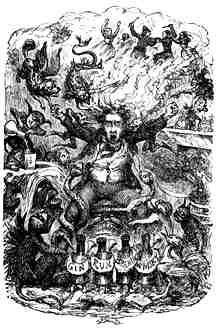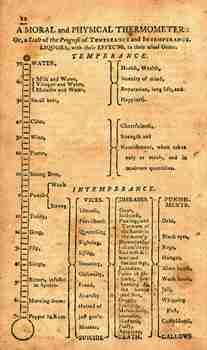
Ardent Spirits: The Origins of the American Temperance Movement—A Virtual Exhibition. http://www.librarycompany.org/Ardent%20Spirits/temperance-index.html
. Jessy Randall, Exhibition Curator and Nicole Ketcham, Virtual Exhibition Design. The Library Company of Philadelphia.
 |
"In the Monster's Clutches."
From Ardent Spirits Web site.
|
This Web site is an accompaniment to the Library
Company of Philadelphia's more extensive exhibit on the origins of temperance
reform in the United States. The site contains information about the exhibit
and a short bibliography
for readers interested in exploring the history of the temperance movement
in 19-century America, but its major component is a well-illustrated,
somewhat breezy virtual
tour of the exhibit. The virtual tour promises to document
temperance reform's "development from moral persuasion to legal coercion,
from Dr. Benjamin Rush's moral
thermometer in the late 18th century to the formation of
the Woman's Christian Temperance Union in the late 19th." To that end,
the Web site leads visitors through brief treatments of the medical
arguments for temperance, the Maine
Law of 1851 and other attempts to limit access to beverage
alcohol, the use by temperance reformers of demonic
imagery and sketches of moral decay to further their crusade,
women's
dry activism, the support systems created for troubled drinkers,
and the place of temperance in American culture.
The virtual tour is stronger on arresting
imagery than it is on logical organization or description. The nightmarish
frontispiece to Timothy Shay Arthur's Grappling with the Monster
(1877), depicting a drinker tortured by demonic imps, snakes, and dogs
and beset by an alcohol-inspired vision of chaotic struggle between women
and policemen, opens the tour. Details from this illustration, entitled
"In the Monster's Clutches," reappear throughout the tour as a kind of
thematic glue. Devil dogs from the same illustration hover on each page,
revealing temperance trivia
 |
Benjamin Rush's "moral thermometer."
From Ardent Spirits Web site.
|
(Edgar Allen Poe was a member of the Sons of Temperance, for instance)
when a visitor passes a mouse over them. My insufficiently powered office
computer was only partially successful at gaining access to these tidbits.
The tour includes a marvelous reproduction of Dr. Benjamin Rush's "moral
thermometer," several humorous temperance-centered
valentines, and a succession of artistic depictions of vomiting
inebriates, including Hogarth's classic "Gin
Lane." A collection
of temperance pledges is one of the most informative pieces
of historical evidence contained in the exhibit tour. The exhibit is best
at depicting the cultural impact of temperance reform, presenting an angelic
advertisement for Hire's
Root Beer, a vocal clip of "Father,
Dear Father," and a good section on T. S. Arthur's classic
Ten
Nights in a Bar-Room.
Historians will nevertheless note important
omissions and weaknesses in the Web site. There is no mention of the Washingtonian
movement, a working-class temperance crusade of crucial significance to
temperance reform, and little discussion of women's organizations (the
exhibit's promise about the WCTU notwithstanding) or prohibition laws.
Nor does the virtual tour distinguish between distilled and fermented alcoholic
drinks (a critical factor in early temperance reform), discuss the long
and short pledges (one repudiating all alcoholic beverages, the other only
"ardent spirits" such as whiskey), or illuminate the shift from temperance
to prohibition. The site's illustrations and text hint at these topics,
but do not discuss them clearly. As a result, historians should use the
Library Company of Philadelphia's Ardent Spirits Web site as they should
alcohol itself, with pleasure but also with moderation and awareness of
its reality-bending properties.
Thomas R. Pegram
Loyola College
~ End ~
Web Site Review of Ardent
Spirits: The Origins of the American Temperance Movement
Copyright
© 1999 by The Journal for MultiMedia History
Comments
| JMMH Contents |

